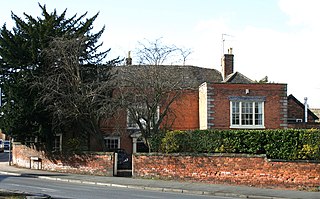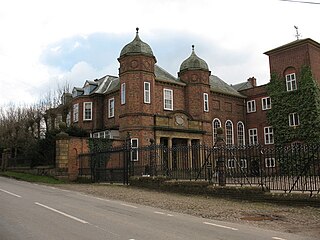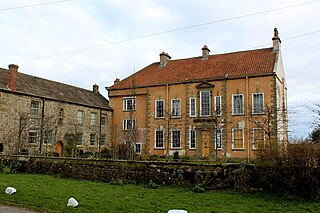
The Aloft Liverpool Hotel, formerly the Royal Insurance Building, is a historic building located at 1-9 North John Street, Liverpool, Merseyside, England. It was built as the head office of the Royal Insurance company.

The Rookery, or 125 Hospital Street, is a substantial Georgian townhouse in Nantwich, Cheshire, England. It is at the end of Hospital Street, on the north side, at the junction with Millstone Lane. The existing building dates from the mid-18th century and is listed at grade II; English Heritage describes it as "good" in the listing. Nikolaus Pevsner describes it as "square and stately." It incorporates an earlier timber-framed house at the rear, which probably dates from the late 16th or early 17th century.

Forest House is in Love Street, Chester, Cheshire, England. It is a former town house that is recorded in the National Heritage List for England as a designated Grade II listed building.

Ince Blundell Hall is a former country house near the village of Ince Blundell, in the Metropolitan Borough of Sefton, Merseyside, England. It was built between 1720 and 1750 for Robert Blundell, the lord of the manor, and was designed by Henry Sephton, a local mason-architect. Robert's son, Henry, was a collector of paintings and antiquities, and he built impressive structures in the grounds of the hall in which to house them. In the 19th century the estate passed to the Weld family. Thomas Weld Blundell modernised and expanded the house, and built an adjoining chapel. In the 1960s the house and estate were sold again, and have since been run as a nursing home by the Canonesses of St. Augustine of the Mercy of Jesus.
Gayton Hall is a country house in Gayton Farm Road, Gayton, Merseyside, England. It was built in the 17th century and refaced in the following century. The house is constructed in brick with stone dressings, and has an Ionic doorcase. William of Orange stayed in the house in 1690. In the grounds is a dovecote dated 1663. Both the house and the dovecote are recorded in the National Heritage List for England as designated Grade II* listed buildings.

Elland Town Hall is a municipal building in Southgate, Elland, West Yorkshire, England. The structure, which was primarily used as an events venue, is a Grade II listed building.

Grimethorpe Hall is a manor house in Grimethorpe, South Yorkshire, England. Built circa 1670 for Robert Seaton, it is thought to be in the style of York architect Robert Trollope. Around 1800 the hall passed to John Farrar Crookes of Tunbridge Wells. It was last used as a house in the 1960s and afterwards was purchased by the National Coal Board. The National Coal Board applied to demolish it in 1981 but, after a campaign by the Ancient Monuments Society, this was unsuccessful. The structure received statutory protection as a grade II* listed building in 1985.

Eaves Hall was built in 1864 for John Burton (1809–1879), first son of James Burton and a wealthy cotton mill-owner.

Helperby Hall is a historic building in Brafferton and Helperby, a village in North Yorkshire, in England.

Cowling Hall is a historic building in Cowling, a village near Bedale in North Yorkshire, in England.

Sorrelsykes House is a historic building in West Burton, North Yorkshire, a village in England. It is noted for the follies in its park.

Buttercrambe Mill is a historic building in Buttercrambe, a village in North Yorkshire, in England.
Bossall Hall is a historic building in Bossall, a village in North Yorkshire in England.

Byram Park is a former country estate in Byram, North Yorkshire, a village in England.

Yew Tree House is a historic building in Cawood, a village in North Yorkshire, in England.
The Old Town Hall Chambers is a historic building in the High Street in Newport Pagnell, a town in Buckinghamshire, in England. The building, which served as a public events venue, is a grade II listed building.

Cononley Hall is a historic building in Cononley, a village in North Yorkshire, in England.

Crakehall Hall is a historic building in Crakehall, a village in North Yorkshire, England.

The Croft Hotel is a historic building in Croft-on-Tees, a village in North Yorkshire in England.

Longley House is a historic building in Easingwold, a town in North Yorkshire in England.

















